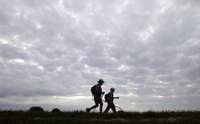The News Press -
11/18/04
Fort Myers, Florida
previous page
By Betsy Clayton
 Sal
Lilienthal has visited five continents, led cycling tours on three of
them and concluded that Lake Okeechobee’s dike trail is among the best
and most beautiful paths on the globe. Sal
Lilienthal has visited five continents, led cycling tours on three of
them and concluded that Lake Okeechobee’s dike trail is among the best
and most beautiful paths on the globe.
The Connecticut bicyclist will return in January to pedal part of the
110-mile trail around the Big O, which is a mere hour’s drive away for
Lee County residents.
“It’s a path, so there’s no cars. It’s flat, so it’s easy. It’s paved,
so there’s no rocks. And it’s very scenic,” said Lilienthal, who heads
the Kent, Conn.,-based Bicycle Tour Company and visited Florida last
week to scout the trail. He also cycled it last winter.
His passion for the Lake Okeechobee — the largest body of fresh water
south of the Mason-Dixon line — is paralleled by hikers. Up to
200 people will circle part or all of Big O starting Saturday in an
annual Florida Trail Association-sponsored walk. They’ll log nine- to
14-mile days on the Herbert Hoover Dike, a 67-year-old structure that
hems in the hidden lake.
The vistas afforded hikers and
cyclists are stunning. Sunrise on the lake’s western edge floods
the lake and surrounding marshes with eye-blinking streaks of crimson
and gold. A sunset from the height of the dike on the eastern shore
makes the shallow lake sparkle and wink.
The sight is rejuvenating for
Floridians who were menaced by the recent hurricane season. Unlike
many of Florida’s outdoor recreation places, Lake Okeechobee’s dike
trail and nine primitive campsites were unharmed.
“Lucky for us, the Lake Okeechobee section of the Florida Trail ...
sustained no direct hurricane damage,” said Sandra Friend of the
Florida Trail Association.
“That’s one advantage of dike walking — no trees to fall across the
trail! I know trees were uprooted in some of the parks along the route
but the Florida Trail itself is just fine,” said Friend, author of the
guide “Along the Florida Trail.”
The trail links from Big Cypress National Preserve to Pensacola. A
full chapter of Friend’s book is devoted to hiking the loop around
Lake Okeechobee.
Now is the time to go. Bugs are at a minimum. Gone are thunderstorms —
serious threats to hikers and cyclists on the exposed trail during
summer.
When the group of hikers leaves Pahokee Marina at 8 a.m. Saturday,
they’ll work their way around the lake as usual, including
Thanksgiving dinner at the Clewiston Inn.
Twenty to 40 hikers are expected to complete the entire loop,
organizer Paul Cummings said. Day-trippers are welcome, too. Hikers
will stay at the Okeechobee KOA the first four days and shuttle to
various legs. Then they’ll move to the South Bay RV Park and do more
of the same.
They’ll discover more miles of paved trail than last year.
The ribbon of asphalt increased from 37 to 63 miles, making the route
attractive to cyclists, inline skaters and others, said Art Ruebenson,
Clewiston-based chief park ranger for the U.S. Army Corps of
Engineers, which manages the dike.
The trail’s remaining 47 miles are an 11-foot-wide
gravel-and-limestone maintenance road with grooves from utility
vehicles.
It’s rare for passing motorists to glimpse the trail because it’s set
back from the highway.
That adds to the mystique of rounding the lake, which for years has
been revered by bass anglers and was made famous in bassing circles by
hall-of-fame angler Roland Martin.
Only recently did people who don’t give a hoot about the lunkers stop
driving on by the leviathan lake.
Now they pitch a tent, grab boots or a bike and take in the vista
afforded those who venture into Florida’s grassy, watery heartland of
cattle, sugarcane, songbirds and marshes.
“You have the canal on one side and the lake on the other side. And
it’s a big lake,” said Lilienthal, the cyclist. “You can’t see the
other side.
previous page
|




 Sal
Lilienthal has visited five continents, led cycling tours on three of
them and concluded that Lake Okeechobee’s dike trail is among the best
and most beautiful paths on the globe.
Sal
Lilienthal has visited five continents, led cycling tours on three of
them and concluded that Lake Okeechobee’s dike trail is among the best
and most beautiful paths on the globe.